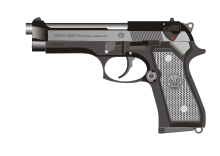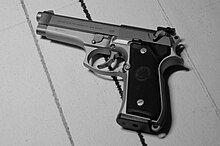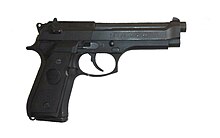
This is when you do not want to see a 92F!


Now I was basically phasing out of the Army National Guard. When “THE WORD” came down about the 1911a1 being replaced by the 92F.

To say that some of the Real Old Sweats were not happy. Would not really do them justice in describing their righteous rage.


But then after the survivors who said “maybe this might be a good thing”. Were either scrapped off the floor or gotten a Dust Off to the Medicos.
So We did like what all good soldiers do.

and then we.

Followed by almost stopping to complain about it for a while & continue the Mission.
Now here is what I found out. It is not that bad a pistol really. As I own one, (The price was too good to pass by the deal)
That & it seems to have the capacity to hold a huge amount of 9mm ammo. (15 rounds outside of the People’s Republic of California!)
Just do not tell that Jerk Mel Gibson about that. As it seems that he never has to reload in the movies.
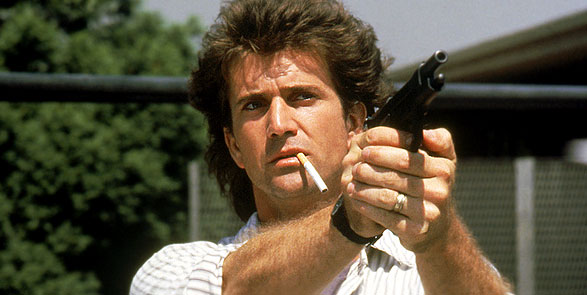
It also has some heft and shoot better at least to than the 45. I also like the sight picture. Here are some of the variations out there.

Now for the not so good news. The Trigger sucks in my humble opinion. Either in the single or double action mode. But maybe that is my problem.
Would I take this gun into a firefight by itself? Oh Hell no! Since I firmly believe that a pistol is really just a badge of rank. That & a gun of last resort.
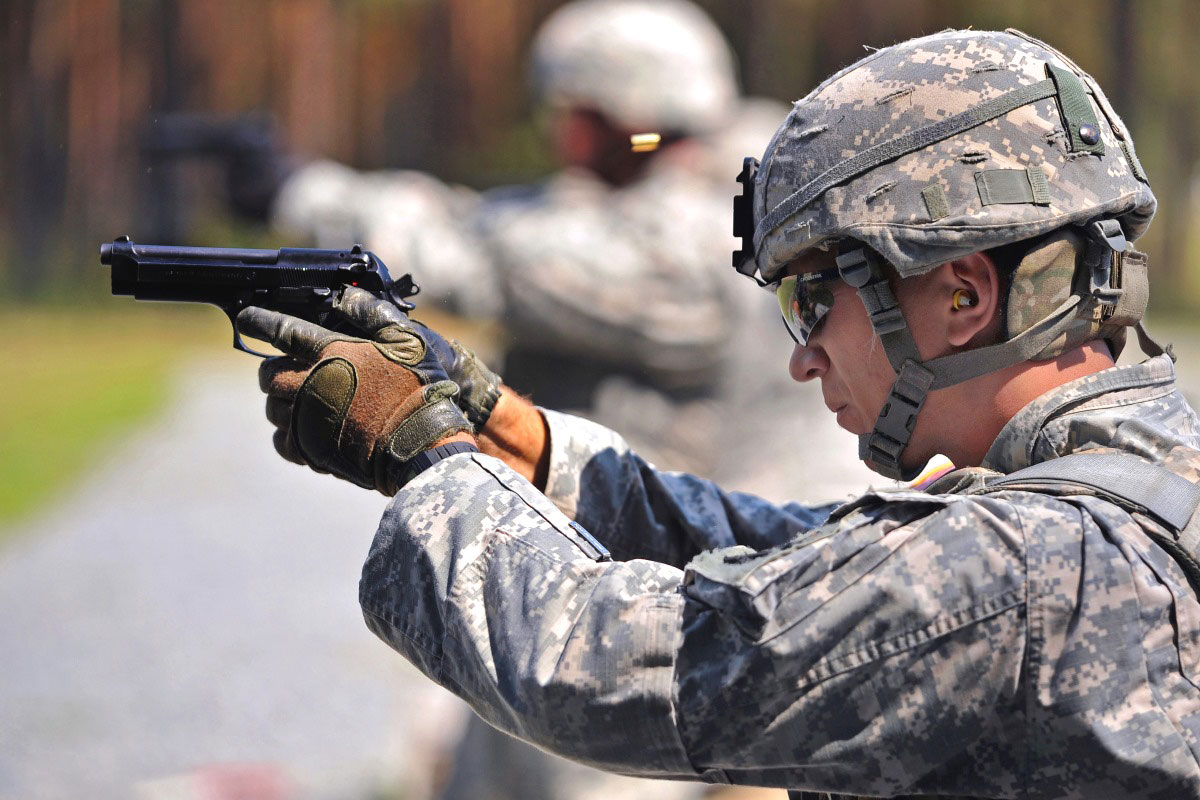
If I could not avoid such a fight or not call in a strike.
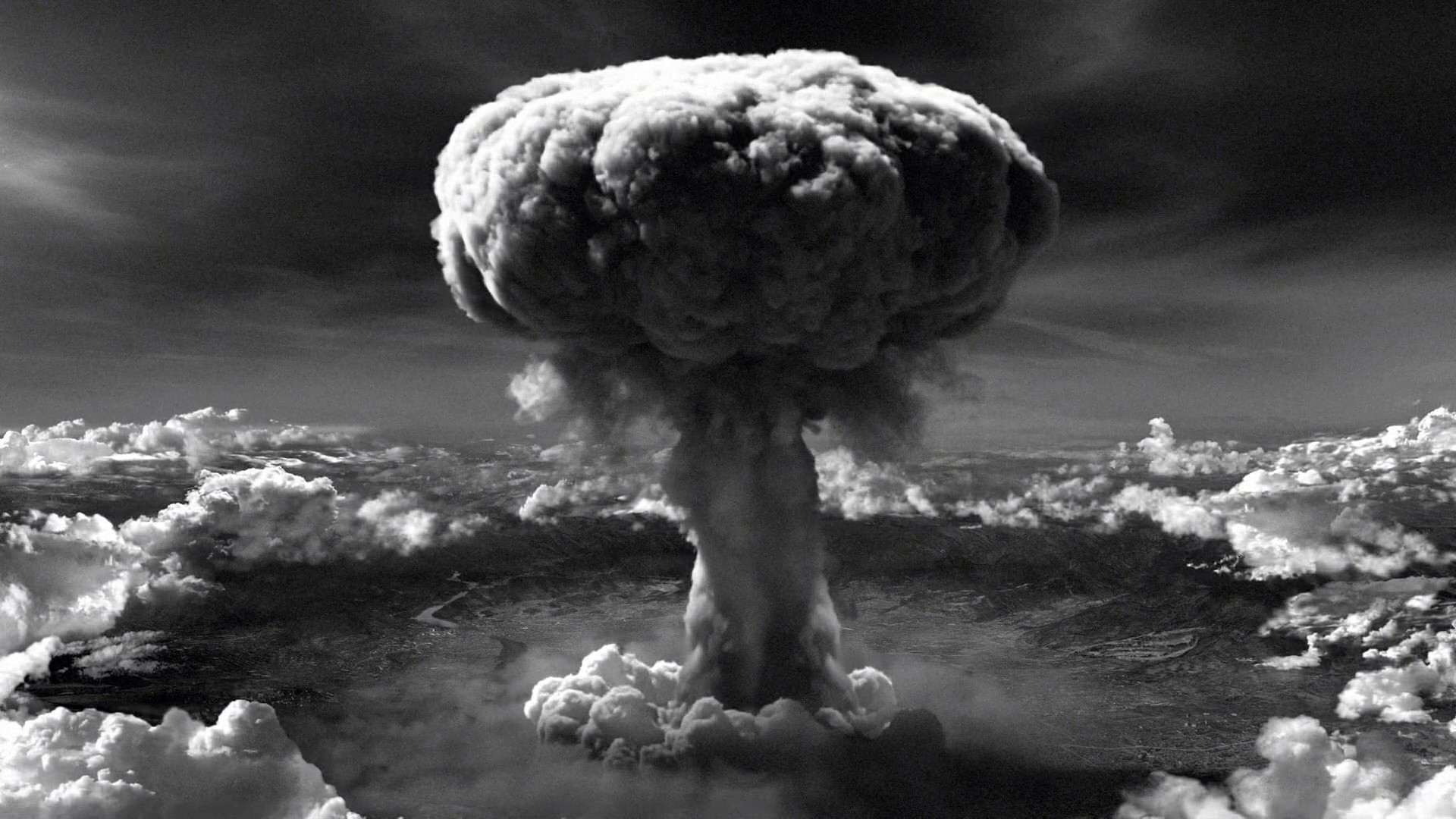
Then I would take an AK-47 to the party.

But hopefully that will not happen again in mine or my family’s lifetime
Here is some more technical information about this fine pistol!
Beretta 92
| Beretta 92 | |
|---|---|
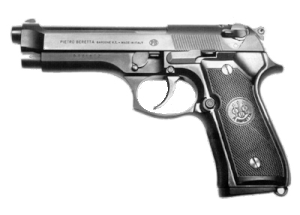
Beretta 92FS
|
|
| Type | Semi-automatic pistol |
| Place of origin | Italy |
| Service history | |
| In service | 1975—present |
| Used by | See Users |
| Production history | |
| Manufacturer | Fabbrica d’Armi Pietro Beretta |
| Produced | 1976—present |
| Variants | See Variants |
| Specifications | |
| Weight |
|
| Length |
|
| Barrel length |
|
|
|
|
| Cartridge |
|
| Muzzle velocity | 381 m/s (1,250 ft/s) |
| Effective firing range | 50 m (160 ft) |
| Feed system | Detachable box magazine:
|
The Beretta 92 (also Beretta 96 and Beretta 98) is a series of semi-automatic pistols designed and manufactured by Beretta of Italy. The model 92 was designed in 1972 and production of many variants in different calibers continues today.
The United States Armed Forces replaced the M1911A1 .45 ACPpistol in 1985 with the M9, a military spec Beretta 92FS.
Contents
[hide]
History[edit]
The Beretta 92 pistol evolved from earlier Beretta designs, most notably the M1923 and M1951. From the M1923 comes the open slide design, while the alloy frame and locking block barrel, originally from Walther P38, were first used in the M1951. The grip angle and the front sight integrated with the slide were also common to earlier Beretta pistols. What were perhaps the Model 92’s two most important advanced design features had first appeared on its immediate predecessor, the 1974 .380 caliber Model 84. These improvements both involved the magazine, which featured direct feed; that is, there was no feed ramp between the magazine and the chamber (a Beretta innovation in pistols). In addition, the magazine was a “double-stacked” design, a feature originally introduced in 1935 on the Browning Hi-Power.[1]
Carlo Beretta, Giuseppe Mazzetti and Vittorio Valle, all experienced firearms designers, contributed to the final design in 1975.[2]
Evolution[edit]
92[edit]
Production began in May 1976, and ended in February 1983. Approximately 7,000 units were of the first “step slide” design and 45,000 were of the second “straight slide” type.[3]
92S[edit]
In order to meet requirements of some law enforcement agencies, Beretta modified the Beretta 92 by adding a slide-mounted combined safety and decocking lever, replacing the frame mounted manual thumb safety. This resulted in the 92S which was adopted by several Italian law enforcement and military units.
92SB (92S-1)[edit]
The 92SB, initially called 92S-1, was specifically designed for the USAF trials (which it won), the model name officially adopted was the 92SB. Features added include a firing pin block (thus the addition of the “B” to the name), ambidextrous safety levers, 3-dot sights, and relocated the magazine release catch from the bottom of the grip to the lower bottom of the trigger guard. The later relocation of the magazine release button means preceding models (92 & 92S) cannot necessarily use later magazines, unless they have notches in both areas.[4]
A compact version with a shortened barrel and slide and 13-round magazine capacity known as the 92SB Compact was manufactured from 1981 to 1991.[4]
92F (92SB-F)[edit]
Beretta modified the model 92SB slightly to create the 92SB-F (the “F” added to denote entry of the model in U.S. Government federal testing) by making the following changes:
- Design of all the parts to make them 100% interchangeable to simplify maintenance for large government organizations.
- Squared off the front of the trigger guard so that one could use finger support for easier aiming.
- Recurved the forward base of the grip to aid aiming.
- Hard chromed the bore to protect it from corrosion and to reduce wear.
- New surface coating on the slide called Bruniton, which allegedly provides better corrosion resistance than the previous plain blued finish.[5]:16
The French military adopted a modified version of the 92F with a decocking-only lever as the PAMAS G1. These pistols have Tellurium in the slide, making the steel brittle and as such only have a service life of approximately 6,000 rounds. [1]
92FS[edit]
The FS has an enlarged hammer pin that fits into a groove on the underside of the slide. The main purpose is to stop the slide from flying off the frame to the rear if it cracks. This was in response to reported defective slides during U.S. Military testing.[6]
Design[edit]
The Beretta 92’s open slide design ensures smooth feeding and ejection of ammunition and allows easy clearing of obstructions. The hard-chromed barrel bore reduces barrel wear and protects it from corrosion. The falling locking block design provides good accuracy and operability with suppressors due to the in-line travel of the barrel. This is in contrast to the complex travel of Browning designed barrels. The magazine release button is reversible with simple field tools. Reversing the magazine release makes left-handed operation much easier.
Increasingly, it has become popular to reduce handgun weight and cost as well as increase corrosion resistance by using polymers. Starting around the year 2000, Beretta began replacing some parts with polymer and polymer coated metal. Polymer parts include the recoil spring guide rod which is now also fluted, magazine floor plate, magazine follower and the mainspring cap/lanyard loop. Polymer coated metal parts include the left side safety lever, trigger, and magazine release button.[7]
Magazines[edit]
To keep in line with the introduction of laws in some locations restricting magazines that hold more than 10 rounds, Beretta now manufactures magazines that hold fewer than the factory standard 15 rounds. These magazines have heavier crimping (deeper indentations in the side) to reduce the available space while still keeping the same external dimensions and ensuring that these magazines can be used on existing firearms. Beretta also produces 15 round “Sand Resistant” magazines to resolve issues encountered with contractor made magazines, and 17 round magazines included with the A1 models. Both magazines function in earlier 92 series and M9 model pistols.
Italian magazine manufacturer Mec-Gar now produces magazines in blue and nickel finishes with an 18-round capacity, which fit flush in the magazine well on the 92 series. Mec-Gar also produces an extended 20-round blued magazine that protrudes below the frame by 3⁄4 inch (19 mm). These magazines provide users in unrestricted states with a larger capacity magazine.
Variants[edit]
The Beretta 92 is available in many configurations and models:
Trigger systems[edit]
- FS Models
- The FS models are Double-action/Single-action (DA/SA) pistols; they have an initial double-action trigger pull subsequently followed by single-action operation. The “FS” models have a safety lever that also functions as a decocking lever.
- G Models
- The G models (so named because this configuration was first designed for the French “Gendarmerie“) feature a decocking lever only instead of the safety-decocking lever of the FS. When the decocking lever is released, it automatically returns to the ready-to-fire position. There is no manual safety.
- DS Models
- The DS models are double action only pistols: the hammer doesn’t stay cocked. Therefore the hammer spur has been removed, and is flush with the rear of the slide. The safety levers serve as manual safeties only and have no decocking feature..
- D Models
- The D models are also double-action only pistols but without the manual safeties.
Models[edit]
- 90Two
- (2006-2012)
- The 90two is a 9mm/.40 variant of the 92-series with a redesigned, thicker slide and frame with an accessory rail, captive recoil spring, internal recoil buffer, replaceable sights, user changeable monogrips and 17-round magazines.[8]
- 92A1 / 96A1
- (2010–present)
- The 92A1 and 96A1[9] were introduced in 2010, based on elements from the 92FS and 90two. The overall shape and styling builds on the 92FS with more parts commonality than the 90-two had. From the 90-two comes a heavier slide construction combined with a slightly altered frame to accommodate the picatinny rail and .40 S&W power levels. While most internal components are compatible with standard 92 models, the slide, frame, captive recoil spring assembly, and takedown lever and button of the 92A1 and 96A1 are not interchangeable with other models other than the 90-two.
- 92G-SD / 96G-SD
- (2002-2005, 2015-)
- The 92G-SD is a tactical variant of the 92G with a Brigadier slide and picatinny rail.
- 96FS
- (1990-2008)
- Variant chambered for the .40 S&W, Succeeded by the 96A1.
- 98F
- Variant chambered for 9×21mm IMI. This option was introduced in 1987 for markets where it is illegal to own a weapon chambered for a military cartridge such as 9×19mm; essentially, this is the case of Italy. There were also about 5000 early 98F manufactured in 7.65×21mm Parabellum.
- Billennium
- (2001)
- A limited-edition (2000 copies) commemorative (of the year 2000) model manufactured in 2001, featuring the heavier Brigadier slide. Only 1000 Billennium pistols were initially imported into the United States, the other 1000 were sold throughout the rest of the world. The Billennium also has a frame mounted safety.
- Brigadier
- (1993–present)
- 60-gram (2.1 oz) heavier slide and 1 millimetre (0.039 in) wider to improve control when firing multiple shots in quick succession. It also includes removable front and rear sights.
- CB
- (1992–1993)
- Single action only. It is designed for sport shooting and includes a front barrel bushing for improved accuracy.
- Centennial
- (2015)
- The 92 FS Centennial limited edition (500 units) commemorates adoption by the Italian Military of Beretta’s earliest semiautomatic pistol, the Model 1915. This Centennial 92 is notable for its frame-mounted manual safety and single-action-only mechanism. The Beretta medallion in each wood grip panel displays the anniversary dates in Roman numerals, which are also engraved on either side of the steel slide. The pistol is packaged in a custom M2A1 ammunition can bearing the Centennial logo.[10][11]
- Centurion
- (1992–2004)
- Shorter barrel and slide (like “Compact”), but with standard-sized frame that has a slightly shorter dust cover. Special G Centurion, DS Centurion and D Centurion models are available in some countries.
- Combat
- (1994–2001)
- Heavier Brigadier slide, single-action only and also designed for sport shooting, including a front barrel bushing for improved accuracy. It also came with an additional longer barrel that was weighted.
- Compact L
- (1992–present)
- Shorter barrel, slide, and more compact frame (13-round magazine capacity).
- Compact M
- (1992–2004)
- Similar to the Compact L, but has a slimmer grip that accepts only a single stacked 8-round magazine.
- Compact with Rail
- (present)
- A compact version of the M9A1.
- Elite I
- (1999–2001)
- Pistols with this option include the heavier Brigadier bruniton slide with front serrations and Elite designation, Inox finish (silver) stainless barrel, thin skeletonized hammer, and bevel of the magazine well. A flat hammer spring cap was standard as well as the decock only (G-Model) feature and dovetailed front sight. It was introduced in 1999 and replaced by the Elite II option in 2001.
- Elite IA
- (2001)
- This option is essentially a black Vertec with a bruniton Brigadier G slide having the Elite 1A designation and a thicker skeleton hammer. The 4.7 in (120 mm) stainless barrel with Inox finish was also changed to the blackened stainless version like black Vertecs.
- Elite II
- (2001)
- This option replaced the Elite I option in 2001 and includes the same features as the original Elite plus removable Novak type sights, extended magazine release catch, checkered front/rear grip strap, thicker (than Elite I) skeletonized hammer, and lighter D-spring. This option is available only with the stainless G-Model slide, also with front serrations. The stainless barrel for the Elite II has a target crown.
- Inox
- (present)
- The Inox models feature the following parts made in stainless steel: the barrel, the slide (including the extractor, the safety and the right-side manual safety lever), the trigger, the trigger pin, and slide stop lever. The aluminum frame is anodized to match the color. Can have either black or stainless controls.
- M9
- (1990-present)
- The M9 is essentially the commercial 92FS as the design was when it was adopted by the US military in the late 1980’s. Subtle differences from a modern production 92FS are a straight dustcover, “snowman” style sights, a straighter grip and military markings.
- M9A1
- (2006-present)
- The M9A1 was adopted by the USMC in 2006. It adds a 1-slot Picatinny rail, more aggressive front and backstrap checkering and a beveled magazine well for easier reloading of the weapon. M9A1 pistols are sold with physical vapor deposition (PVD) coated magazines developed to better withstand the conditions in the sandy environments in Iraqand Afghanistan.[12]
- M9A3
- (2015-present)
- The M9A3 (the M9A2 concept never went into production) was released in 2015 as part of the Modular Handgun System trials. The main updates to the M9A3 were a 3-slot Picatinny rail, thinner vertical grip, removable wrap-around grips that can be swapped between Vertec-style and ‘old’ M9 style[13], fully removable sights and a universal slide, which makes the gun convertible from decocker-safety to decocker-only mode. Additionally, the M9A3 comes with 17-round sand-resistant magazines in a beveled shape for easier reloading.
- Steel I
- (2004)
- Nickel-plated carbon steel, single-action-only, collector’s model. [Edit: Both single-action-only and single/double-action variants exist. Also used for competitive shooting because of its steel frame (for added weight and strength), the frame-mounted safety and/or Vertec-style grip-frame that are all desirable features in a competition gun.]
- Stock
- (1994–present)
- Heavier Brigadier slide. It is also designed for sport shooting and includes a front barrel bushing for improved accuracy.
- Vertec
- (present)
- Thin Vertec polymer grips, flush muzzle with slide, and dovetail target sights. Late models have an underbarrel 92A1-style Picatinny accessory rail.
- Wilson Combat 92G Brigadier Tactical
- (2014 to present)
- Made in collaboration with Wilson Combat,[14] these pistols differ from the standard Brigadier in that they have a military standard 1913 picatinny rail, all steel controls (as opposed to the polymer coated steel), decock only feature (G-model), 4.7″ target crowned barrel, fluted steel guiderod, thin profile G-10 grips, rounded trigger guard, the lighter hammer spring used in the “D” model, Elite II hammer, and their own unique serial number with a “WC” prefix among other features.
93R machine pistol[edit]
The Beretta 93R is a significantly redesigned 92 to provide the option of firing in three-round bursts. It also has a longer ported barrel, heavier slide, fitting for a shoulder stock, a folding forward grip, and an extended magazine. Unlike other Berettas in the 90 series it is single-action only, does not have a decocker, and very few are around today.[5]:12–13
Copies[edit]
The Beretta 92 was designed for sports and law enforcement use and, due to its reliability, was accepted by military users in South America and other countries all over the world.
- Brazil
- A large contract for the Beretta 92 was with the Brazilian army, for which Beretta set up a factory in Brazil. This factory was later sold to the Brazilian gunmaker Taurus (Forjas Taurus S/A). Taurus makes pistols called PT92without the need for a license from Beretta since their design is based on the original Beretta 92, whose patents have since expired.
- The PT92 can be distinguished from its modern Beretta counterpart primarily by having the safety mounted on the frame as opposed to on the slide like the Beretta. Though mechanically similar to the original, the PT92s differ from the early 92s by having a trigger guard similar to the modern 92s (the originals were rounded) and a magazine release in the same place as the modern 92s (the originals were at the bottom of the grip).
- Turkey
- Turkish companies MKEK and Girsan manufactured a copy of the Beretta 92F as Yavuz 16 for the Turkish Armed Forces and General Directorate of Security.[15][16] There has been speculation that these were being made under contract from Beretta. Some of these pistols were imported into the United States by the company American Tactical Imports as the American Tactical 92 or AT-92. Yavuz 16 was exported to Canada, Colombia, Georgia, Malaysia and Syria.[17]
- France
- France has made licensed copies of Beretta 92FS as the PAMAS G1 and the French-M92 is now in use in the Armies and law enforcement agencies, only to be replaced by the SIG SP2022 in the national police.
- Taiwan
- Taiwan had made Beretta-like pistols namely the T75 Pistol.
- South Africa
- South Africa had produced the Beretta under license since 1992 as the Vektor Z88, and the batches are used by the South African Police.
- Egypt
- Egypt had produced the Beretta 92 under license as the Helwan 920 with the magazine release button at the bottom of the magazine.[18]
Users[edit]

